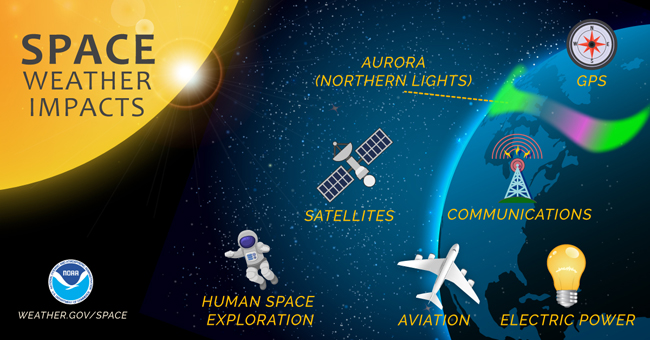
In order to protect people and systems that might be at risk from space weather effects, we need to understand the causes. The sun is the main source of space weather. Eruptions of plasma and magnetic field structures from the sun's atmosphere, called coronal mass ejections (CMEs), and sudden bursts of radiation, called solar CMEs, can cause space weather effects at or near Earth. Luckily, Earth's magnetosphere, ionosphere, and atmosphere do a great job of protecting us from the most hazardous effects.
If a CMEs arrives at Earth, it can produce a geomagnetic storm, which, in turn, can cause anomalies and disruptions to the modern conveniences we have come to rely on. For example, fluctuating magnetic fields associated with these storms induce currents in long wires like power lines, potentially leading to wide-spread blackouts in extreme cases. On March 13, 1989, a powerful geomagnetic storm triggered a major power blackout in Canada that left 6 million people without electricity for 9 hours. According to the North American Electric Reliability Corporation (NERC), the CME disrupted electric power transmission from the Hydro Quebec generating station and even damaged some power transformers in New Jersey. Power outages due to space weather are rare events, but evidence suggests that significant effects could occur. Significant power outages may have cascading effects, causing loss of:
Space weather caused problems even before the widespread generation and distribution of electrical power. The strongest geomagnetic storm on record occurred in September 1859, known as the Carrington Event, after the British astronomer Richard Carrington. During this storm, excess currents were produced on telegraph lines, shocking technicians and in some cases, setting their telegraph equipment on fire. Aurorae, another feature of geomagnetic activity, were visible as far south as Cuba and Hawaii. Today, a storm like that would cause significant impacts on our technology.
We don't rely on telegraph networks to communicate anymore; however, our communications technologies are still vulnerable to space weather impacts. Solar CMEs sometimes produce energetic particles (protons and electrons) that stream to Earth and are captured by Earth's magnetic field. These particles can damage satellites used for commercial communications, global positioning, intelligence gathering, and weather forecasting, and cause high-frequency radio blackouts in the polar regions. Solar CMEs also cause radio blackouts on the sun-facing side of the Earth.